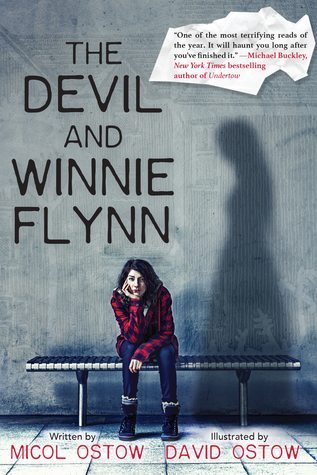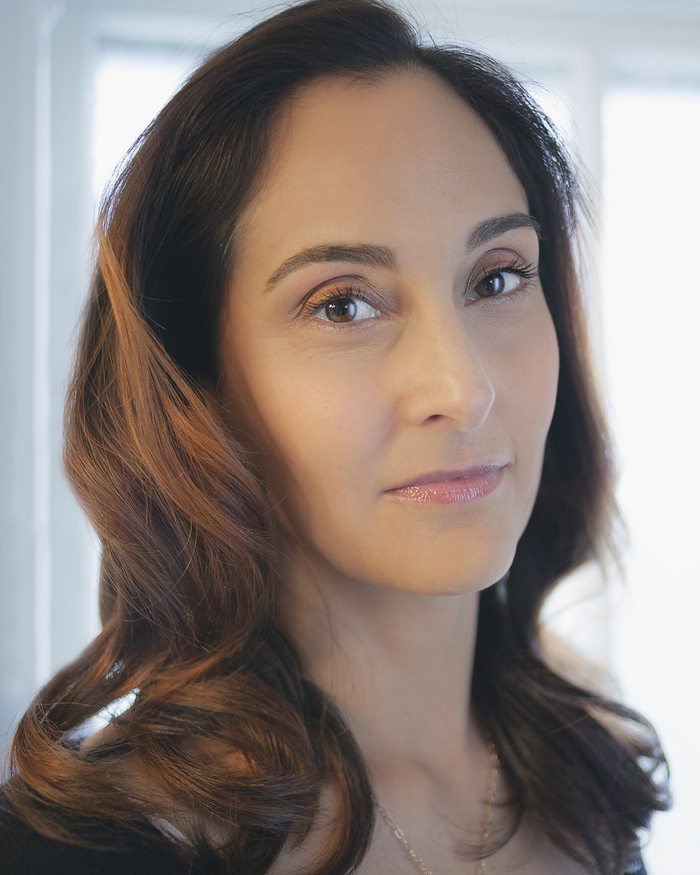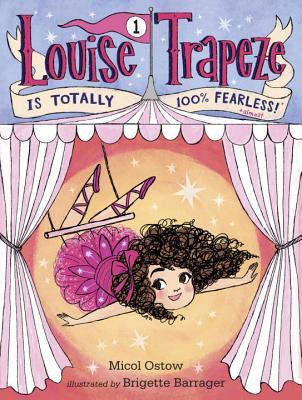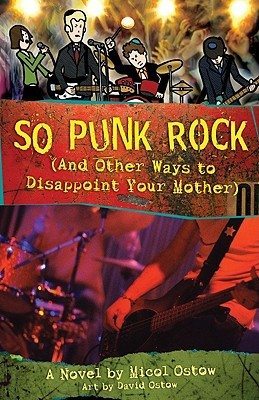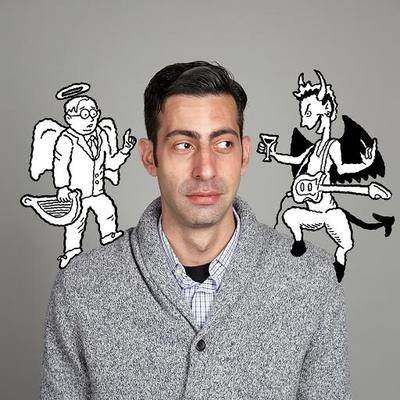You probably know prolific YA author Micol Ostow from her Bradford series following the secrets and friendships of 3 wealthy girls at a prestigious Philadelphia prep school. Or you might know her from her book for younger readers, the indomitable Louise Trapeze. But now this busy writer is back with a stand alone thriller set in her native New Jersey, The Devil And Winnie Flynn. But Winnie isn’t your typical YA horror novel. The structure of Winnie is very unique, and part of that distinctness is due to the fact that the novel is partially illustrated in collaboration with Micol’s brother David. This isn’t the first time the bro/sis duo have teamed up in the publishing world–the siblings are also the creative minds behind the wannabe rockers tale So Punk Rock: And Other Ways To Disappoint Your Mother from 2009. And now the two have collaborated again in quite a different genre to bring us the tale of Winnie whose story is told partially through illustration, but also in the format of an ongoing letter to a friend. Winnie’s story is that of a girl at a crucial time in her life–she’s attempting to process the suicide of her mother all while visiting her Aunt in New Jersey and working with her on the set of a reality TV show. Winnie is part mystery, part self-discovery tale, and part cultural critique, but it’s 100% engaging. YE was lucky enough to get some time with these talented siblings to discuss Winnie, their collaboration process, and what the future holds for their respective endeavors!
Micol, your body of work is a bit prolific. Describe your process. How do you stay focused, on a practical level? And for both of you, on a creative level, how do you keep the buzz of new ideas flowing?
MO: I left publishing in 2007 to get my MFA in writing for children, and to concentrate on writing full-time. So that makes it a little easier to keep the word count up! Although I will say that being busier always forces me to be more efficient… As for the buzz of new ideas, I think that’s part of being a writer and a creative person–they come out of nowhere! Some of them go nowhere, too–that’s the corollary. But I keep a notebook around and jot down ideas–sometimes even just phrases that stick in my head–so that there’s always a list to go back to. In my experience, though, the ones that really take off are the ideas that demand immediate attention, that you don’t have to write down or remind yourself to go back to.
DO: My body of work is not nearly as prolific as Micol’s but it is incredibly scattered. I tend to draw in whatever style I feel like drawing at any particular moment and about whatever subject matter I happen to be fixated on at the time. My Instagram feed is all over the place. Keeping the buzz of new ideas flowing is never the problem. To the contrary, I need to work harder to keep new ideas from cannibalizing the ones I’m already working on!
Speaking of inspiration, was there any particular inspiration for The Devil and Winnie Flynn? How’d the notion to do part illustrative work come about?
MO: My editor for the book had read my previous illustrated collaboration with my brother, So Punk Rock (and Other Ways to Disappoint Your Mother), and he was a big fan. He approached us about doing something illustrated for his new line of YA mysteries at Soho Teen. I had NO IDEA what we’d write about, but my brother clung to the adage of “write what you know” – in other words, Jersey, where we grew up. And when we asked ourselves, ‘What’s so mysterious about New Jersey?’ And the New Jersey Devil of course came to mind.
DO: Yeah, we were actually approached as a team for this project so there was no question from the start that there would be illustration. However, the drawings in our first book together were fairly crude–which was appropriate for the tone of the book–and often took the form of comics which told little stories themselves. Winnie is darker and it was a challenge for me to figure out what and how to draw in a way that would add something to the story.
Tell us a bit about Winnie and what drives her. What type of girl is she?
DO: From my point of view, Winnie is the closest Micol has ever come to writing as some version of herself. That is, I think there’s a lot of Micol in Winnie. But maybe Micol would disagree.
MO: Winnie is a straight shooter. She has no time for BS in her real life… but she loves to lose herself in trashy pop culture. In that way she and I are a lot alike. She’s also very hurt and confused as to why her mom committed suicide, which is very raw and recent when the book opens.
The themes inherent in the book sort of transcend the actual story line itself–social/media commentary, etc. What can you tell us about how that came to be?
MO: As a writer I think it’s dangerous and even counter-productive to specifically try to write TO a theme. It can come across as heavy-handed, in my experience. So I suppose that the messages that did emerge in Winnie’s story did so organically, and I have a hard time articulating them. I think it’s a story about identity, family, and forgiveness, among other things. (Also reality tv!) But those themes emerged from the plot rather than being stuff I tried to squish in to make a point. My dirty little secret is that half the time I have no idea what point I’m trying to make until the book is done (and even then sometimes it’s still unclear until a reader tells me what he/she thinks).
DO: For me as the illustrator, I didn’t think so much about theme as tone. I wanted the drawings to contribute to the general atmosphere of the book.
Of all your original characters, do you have a favorite? Or one that you identify with the most?
MO: I adore my chapter book character, Louise Trapeze, who is basically ten thousand percent thrilled to death with who she is and how she lives, all the time, even when she experiences doubt or setbacks. We should all be as sassy as that gal. Louise just wears it all on her sleeve, even when she doesn’t mean to. Also, she can fly on the trapeze, which is just badass.
DO: In our first collaboration, So Punk Rock, every character was some combination of people Micol and I remembered from high school. Jonas was a fairly cartoonish take on the A-list popular kid at a suburban Jewish Day School. He was fun to play around with.
You swing back and forth between genres…is there one in particular you feel most comfortable in?
MO: Generally I prefer darker stories when I’m writing YA, but I think the reason I do swing back and forth so much is to stay nimble and cleanse my palate. I never get bored! I love being able to go back and forth from Louise Trapeze to something spooky like Amity.
I see you’ve also written installments in other series like Charmed. How does it feel to write from the perspective of someone else’s characters?
MO: There are constraints to writing into an ongoing series with its own canon and mythology, and you also have to be sure you’re respecting the vision of the property’s creators. You definitely have to check your ego at the door to write series or licensed fiction and be ready to tear apart anything the licensor or series creator isn’t feeling. But I think that’s a great reality check for any writer and a nice reminder that we all need some distance from all of our work, now and then. And frankly it can be a HUGE relief to play in someone else’s sandbox now and then. Also they usually help you with plotting. Bonus!
Tell us about the collaborative creative process!
MO: Really, the only person I’ve collaborated with is my brother. So I can’t speak to a ‘typical’ co-writing experience. We do a lot of the brainstorming and plotting together, but we work separately. So it’s kind of the best of both worlds in that we can work in our respective typical styles and patterns, but we have each other to bounce ideas off of, and we’re feeding each other pages and illustrations as they emerge. It’s pretty painless from where I sit but then again, that could be because I’m the older sister, and I’m pretty bossy. Dave may have another answer.
DO: As a sibling, yes, Micol has always been . . . I don’t want to use the word bossy (even though she did), but let’s just say she’s never been shy about giving me her opinion. As a collaborator, she’s been shockingly deferential. She lets me do my thing and when changes need to be made (on the writing side or the drawing side) there’s never any finger pointing. It’s always very constructive.
What’s up next for you both? Any new series or installments, or another stand alone?
MO: I’m working on a new YA, but it’s way too early to say much about it. I also have three more books in the Louise Trapeze series set to release, with #2 coming in February. And hopefully there will be even more where those came from!
DO: I have some stories in the works that I hope to find a home for in the coming year. They’re for the most part expansions on the short form humor stuff that I do online.
What do you guys like to read?
MO: Oh, I read everything, but I’m a sucker for a dark, twisty psychological thriller or mystery. I just started Everything, Everything by Nicola Yoon and am loving it. I also really love narrative nonfiction. I adore Mindy Kaling and devoured her recent Why Not Me?
DO: I go through phases. For some reason I just went through an 80’s phase that had me reading Bright Lights Big City and Less Than Zero. Last year I read several novels by Donna Tartt, and those were great. I own several volumes of the Collected Works of R. Crumb which I like to read but mostly I just stare at the drawings.
Awesome! Be sure to check out The Devil and Winnie Flynn out in bookstores now!
